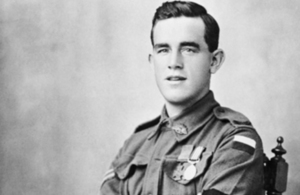WW1 Australian VC recipient Thomas Leslie (Jack) Axford
The story of Australian First World War Victoria Cross recipient Thomas Leslie (Jack) Axford.

Thomas Leslie (Jack) Axford [Credit: Australian War Memorial PO2939.030]
66 men from Australia received the Victoria Cross, Britain’s highest award for gallantry, during the First World War. As part of the centenary commemorations the people of the United Kingdom marked their gratitude to those courageous men by presenting a bronze memorial plaque to their home country engraved with their names. The plaque is now displayed at the Australian War Memorial. This archive tells their stories.
Name: Thomas Leslie (Jack) Axford
DOB: 18 June 1894
Place of Birth: Carrieton, South Australia
Date of Action: 4 July 1918
Place of Action: Vaire and Hamel Wood, France
Rank: Lance Corporal
Regiment: 16th Battalion, Australian Imperial Force
Thomas Leslie (Jack) Axford was born in South Australia on 18 June 1894, but moved to Coolgardie, Western Australia as a small child. He was working as a labourer in a brewery when he joined the Australian Imperial Force in July 1915, and was assigned to the 16th Battalion. He arrived on the Western Front in 1916, and fought at Mouquet farm near Pozières, where we was treated for shell shock before re-joining his unit. In 1917 he received a shrapnel wound during fighting in Belgium, and was treated in England before returning to his unit in early 1918.
During the course of 1918, Lance Corporal Axford was to be awarded both the Military Medal and the Victoria Cross, the latter on 4 July 1918 when he attacked an enemy machine-gun position during the Battle of Hamel in France. His citation reads:
For Most conspicuous bravery, and initiative during operations. When the barrage lifted and the Infantry advance commenced, his platoon was able reach the first enemy defences through gaps which had been cut in the wire. The adjoining platoon being delayed in uncut wire, enemy machine guns got into action and inflicted many casualties, including the Company Commander. Lance-Corporal Axford, with great initiative, and magnificent courage, at once dashed to the flank, threw his bombs against the machine-gun crews, jumped into the trench, and charged with his bayonet. Unaided he killed 10 of the enemy and took six prisoners: he threw the machine-guns over the parapet, and called out to the delayed platoon to come on. He then rejoined his own platoon and fought with it during the remainder of the operations. Prior to the incidents above mentioned he had assisted in the laying out of the tapes for the jumping off position, which was within 100 yards of the enemy. When the tapes were laid he remained out as a special patrol to ensure that the enemy did not discover any unusual movement on our side. His initiative and gallantry undoubtedly saved many casualties, and most materially assisted towards the complete success of his company in the task assigned to it.
After the war, Axford returned to Australia and his previous job in the brewery. He later married, and worked as a clerk, before serving during the Second World War. He died in 1983, at the age of 89.